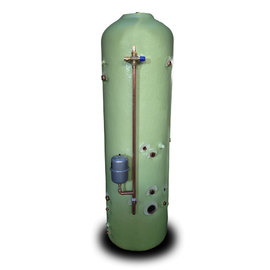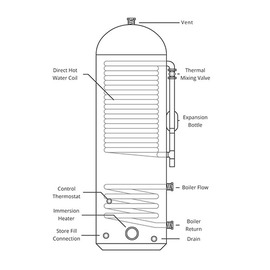Thermal stores and 'stratification'
The volume of water in a thermal store does not change other than through expansion and contraction and heat is transferred from this 'stationary' water through a heat exchanger to where we need it. Both the size of the store and the surface area are critical to achieve an efficient system. Recently manufacturers have used the internal heat exchange surface as a pre heat for domestic hot water to then enter a secondary external heat exchanger. In order to make the external heat exchanger operate quickly enough for domestic hot water you need an additional circulator pump. The critical factor in play here are the flow rate, the surface area of the heat exchanger, the incoming water temperature and the desired leaving water temperature. How does this affect stratification and the efficient working of the thermal store?
Thermal stores are usually designed with input and output heat exchanger coils placed in the optimum position for their desired flow temperature. For example domestic hot water heat exchangers always draw from the top of the store where it is hottest, central heating from somewhere in the middle and solar thermal input at the bottom. Stored water leaving the domestic hot water heat exchanger should be as cold as possible and should re-enter the thermal store at a suitable position. If the water leaving the heat exchanger is 40 degrees ( a drop of 20 across the exchanger) it should re-enter at the mid-point of the store. If this water enters the store too far down then mixing will occur. The result of this is a fairly even temperature from top to bottom after showers or baths. This is where inefficiency can creep in if you have solar thermal going into the store too. A conventional cylinder will always have cold water at the bottom supplied from the 'cold feed'. This is not the case with a thermal store and the higher the base temperature the more low grade heat you miss from the collectors – something to think about!
Specify the largest temperature drop across the heat exchanger as is possible, and make sure the return from that exchanger is in an appropriate position on the store for the 'leaving water temperature (LWT)















